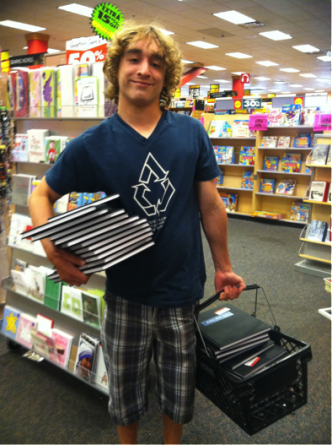Janet Tashjian's Blog, page 2
September 1, 2013
July 23, 2013
A Tribute to Bill Watterson
During school visits, students often ask why I dedicated MY LIFE AS A BOOK to Bill Watterson, creator of the legendary Calvin and Hobbes comic strip. Do I love Calvin and Hobbes THAT much?

Yes I do, but that’s not the only reason why. I dedicated MY LIFE AS A BOOK to Bill Watterson because he’s done more to teach boys to read than any children’s book author I know.

But what about Jack Gantos, you ask? Or Jon Scieszka? Jeff Kinney?
Those authors have written wonderful and beloved books for boys. But unlike those authors, Watterson didn’t write for children – kids just discovered his work and appropriated it as their own.
My young son Jake and his friends adored Calvin and Hobbes; they spent hours laughing and reading through all the different volumes. I found it strange that these boys who enjoyed reading would run screaming down the street as if on fire when they were asked to read for school. What was it about Calvin and Hobbes that made THAT kind of reading so different?
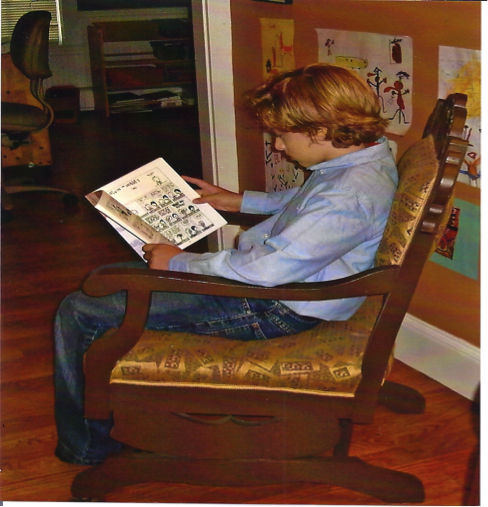
Well there’s a lot to like in those strips: Calvin’s many alter-egos, the sacred moments of communing with nature, the parents who never understand, the battle-axe teacher, the love/hate relationship with the girl next door, not to mention the stuffed animal-best friend who only comes alive for you. But apart from those kid-friendly features, Watterson makes children work for their enjoyment too. Consider the vocabulary from a random strip (February 22, 1990):

Words like progressing, abstraction, inadequacy, traditional, imagery, convey, abandoning, representationalism, interpretation, visceral, oeuvre, monochromatic – those words would be daunting on an SAT test! Yet these comics are cherished by elementary and middle school students too. Why did my son and his friends embrace these words in Watterson’s strips but reject them in novel form? The conclusion I came to was that humor and visual support lessened their fears of such a daunting vocabulary.
So I set out to write a novel with the same fast, comic energy as a Calvin and Hobbes strip, also utilizing visual support. To start, I went to the biggest expert I knew – my son.
Besides being a big fan of comics, Jake has been drawing his vocabulary words since third grade. He’s a visual learner and drawing was the only way he could remember the assigned words.
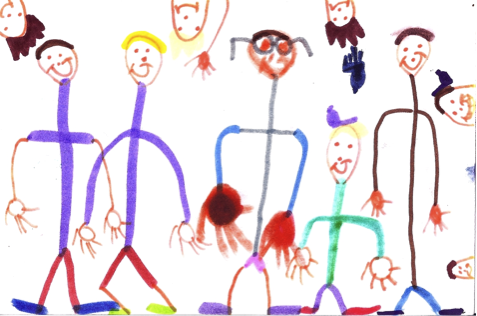
People who saw his work loved the deceptively simple drawings so I had him illustrate the tougher vocabulary words I used in the novel, the same way my main character did. When I submitted the first few chapters to my editor, she told me it was wonderful that I’d hired a cartoonist to illustrate the book. I told her afterward the artist was my teenage son.
Since then, Jake and I have talked to tens of thousands of students about MY LIFE AS A BOOK, MY LIFE AS A STUNTBOY, and the brand-new MY LIFE AS A CARTOONIST. We get letters every week from students who enjoy the books not just for their humor, but for how Jake’s illustrations have helped them learn new words. Teachers from around the country use the books in classrooms and have students draw their own versions of the vocabulary words. What started out as a homage to Bill Watterson ended up being something fun and educational on its own.
I’ll leave you with the Calvin and Hobbes strip I used at the end of MY LIFE AS A BOOK:

Concise. Funny. Relatable. How can you improve on that?
July 13, 2013
My Life As A Cartoonist
In my new book, MY LIFE AS A CARTOONIST, the main character, Derek, draws a comic strip where his pet monkey transforms into a hero called SUPER FRANK. This made me wonder what kind of super powers I’D like to have – not to vanquish bad guys and evildoers – but to help me with my writing. Like Derek, it didn’t take long for me to get into super-hero mode – here are some features I’d love to have on my tool belt of gadgets:
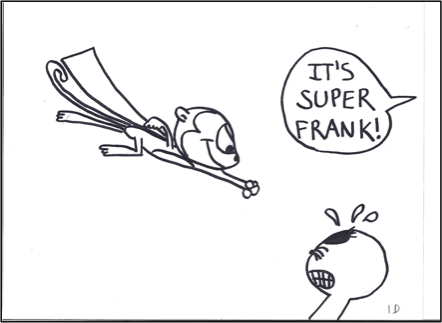
THE CRANIUM SHIELD – this protective covering stops all new and fabulous ideas in their tracks as they try to interrupt me while I finish another project. Every You-Have-To-Work-On-This-Immediately scheme will be overpowered by this deluxe shield, not to appear again until the original project is completely, 100% done. So the next time a tiny part of my brain asks, “Are you SURE you don’t want to hear this amazing idea for the Next Giant Bestseller?” I know the Cranium Shield has me covered. Unless the idea is REALLY astonishing….NO! There, it just stopped another one. Whew!
NINJA SHINY STARS – unlike the throwing stars Ninjas use, my throwing stars only target Kirkus, Booklist, Horn Book, and School Library Journal – turning an everyday positive review into a sparkly, glittery Starred Review. (When they’re not being used to accessorize reviews, these stars make great earrings.)
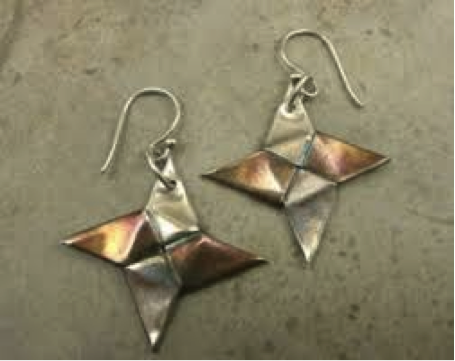
CONVERSION RAY GUN – its powerful rays convert an entire book from any language around the world to English so I can see for myself how accurate the translations of my novels are. MY LIFE AS A…PODIATRIST? No! It’s CARTOONIST! CARTOONIST!
TELEKINETIC FLIPPING – this amazing super power automatically flips my books 45 degrees on a bookstore shelf as soon as I enter the store so the books go from spine out (boo!) to cover out (yay!) The telekinesis is thwarted, however, if any of my books are placed on the same shelf as Stephen King’s CARRIE.
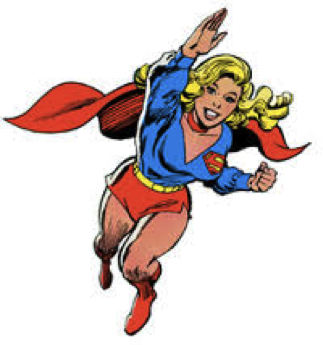
PONCHO OF PATIENCE – this magical cloak guards me during the interminable time that I wait for my editor to read one of my manuscripts. The poncho is safe and comforting, fighting off self-doubt and what-if’s during this vulnerable period. An optional feature lets the security of the poncho extend through the entire rewriting process.
TECHNO THWARTER – this is actually a sidekick of the CRANIUM SHIELD, but instead of obstructing my own ideas, the TECHNO THWARTER zaps my laptop so it can’t access the Internet during my writing time. This handy feature also blocks all tweets, phone calls, and emails as I work. Oh wait, there are REAL techno thwarters to block ALL of these things. Maybe it’s time to stop making up super powers and just get back to work….
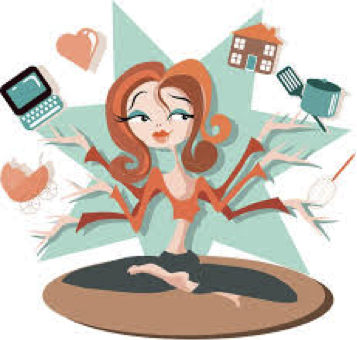
The History of the Stick Figure
In our overcrowded visual culture, perhaps there’s nothing as basic and uncluttered as a simple stick figure. But don’t let their unfussiness fool you; the saga of the stick figure is rich and diverse.
The first petroglyphs appeared 50,000 years ago in caves found in Europe, Africa, and Australasia. Archeologists now claim these pictographs carried magical and religious meaning. But stick figure drawings have modern significance too.
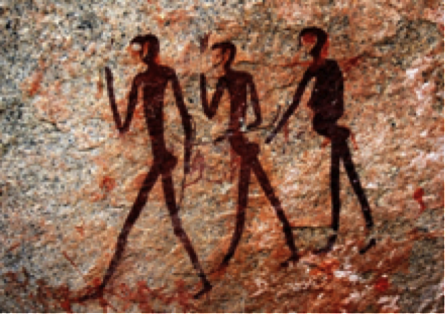
In the 1920’s, Otto Neurath, part of the Vienna Circle of philosophers, developed a system he called ISOTYPE (International System of Typographic Picture Education.) Neurath’s idea was to represent quantitative and qualitative information with easily recognized symbols to help grownups and children interpret their world. He described his work as a “helping language” and a “visual education.”
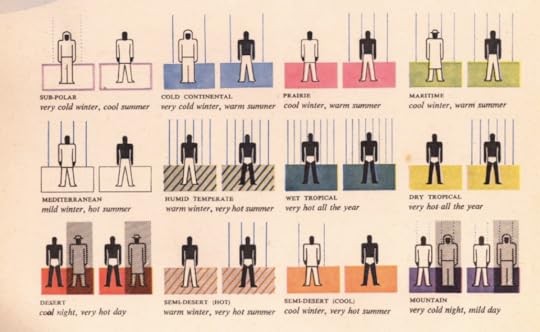
The next big jump in stick figure design was at the 1964 Tokyo Summer Olympics where Masaru Katzumie and Yoshiro Yamashita began the initial steps in creating the first international pictograms. These designs were taken further in the 1972 Munich Summer Olympics when Otl Aicher designed the rounded, geometric stick figures still in use today.
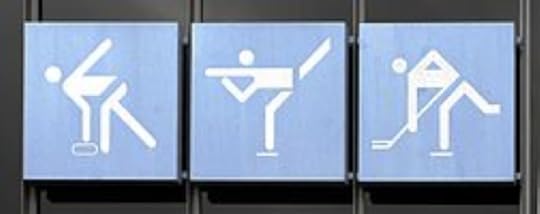
One of Aicher’s stick figure designs from those Olympics, one is seen by millions now each and every day:

Soon afterward, the U.S. Department of Transportation hired the AIGA (American Institute of Graphic Arts) to develop signs so people of different languages could understand the rules of the road.
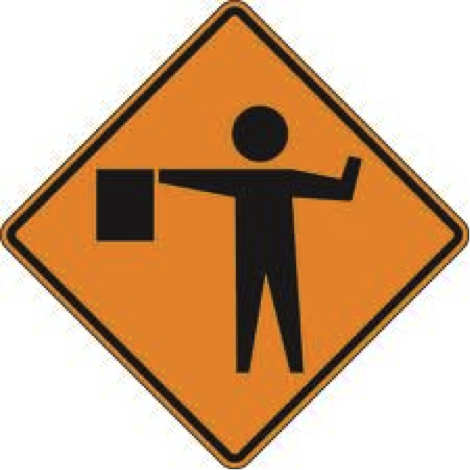
Much like Neurath’s focus on “visual education” the main character Derek in my novels MY LIFE AS A BOOK, MY LIFE AS A STUNTBOY, and MY LIFE AS A CARTOONIST draws stick figures to learn his vocabulary words. My son Jake learned his vocabulary words this way and illustrates the series. His stick figure cartoons may look rudimentary but like Neurath’s work, they communicate vast amounts of information in just a few lines. I’d even argue that Jake’s illustrations convey more than information but emotion too. Here, a stick figure illustration for the word OVERWHELMED:
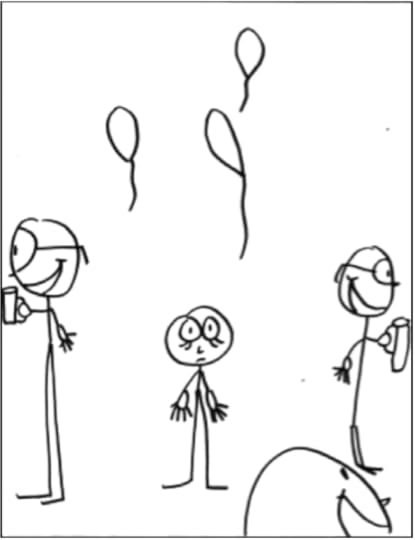
I remember the pang of recognition when Jake first showed me this drawing, recalling how many situations I’d felt as overwhelmed and inundated as this stick figure is. Not a simple feeling at all.
I’m happy we’ve created a series that uses a visual language to reach children, employing a system of communication going back tens of thousands of years.
And words? We like those too.
Cartoonist Blog – Handwriting
When I went out with some MG and YA writers recently, several of the other (younger) authors were SHOCKED when they found out I write most of my books by hand, as if writing with pen and paper was not even physically possible in these days of wall-to-wall technology. Don’t get me wrong – I love a shiny MacBook as much as the next person – but when it comes to getting ideas down, pen and paper is still my go-to method of self-expression.
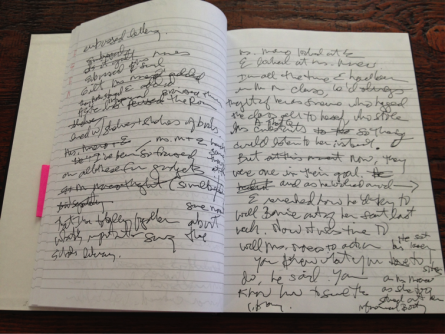
And not just ANY pen and paper. A Uniball Impact 207 and the linen-covered lined journals they used to sell at Borders. (Moment of silence, please.) When Borders announced they were closing, my first thought was how sad, because they’d always been so supportive of my career. But my next thought was – how am I going to write my books without THEIR books? I called people around the country to visit their local Borders and buy out these specific journals. Friends chided me for being superstitious – can’t I write in ANY blank journal? I wasn’t sure I could.
On our way to the Martha’s Vineyard ferry – where a key scene in MY LIFE AS A BOOK takes place – we stopped at the Kingston, MA Borders as a last-ditch effort. My good friend Marianne had already bought out the five journals they had left, but as if they were expecting me early that morning, a young man began putting out a new, gleaming stack of journals – just waiting to be filled. My son and I filled our baskets with every last journal and sketchpad we could carry. The woman behind me in line said I probably wouldn’t be saving any money by the time I shipped all of those books back to California. I told her I wasn’t worried about saving money, but saving my career.
Because I know first hand (no pun intended) how important the connection is between hand, brain, and heart, I ask children visiting my website to write letters instead of emails when they want to talk about my books. And when I do writing workshops in schools, I always ask that students write by hand.
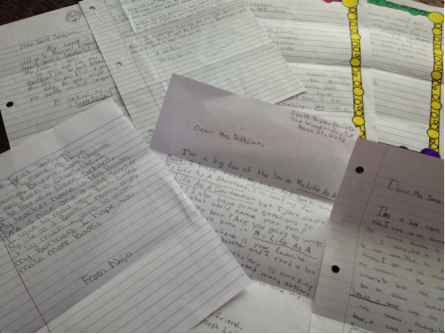
I’m not the only one who thinks writing in longhand is important. TheRumpus.net is a website that asks authors to hand-write letters to young readers. (I recently wrote one, accompanied by some of Jake’s illustrations from MY LIFE AS A CARTOONIST.) And a recent study by Virginia Berninger – a professor of educational psychology at the University of Washington – showed that students in grades two, four, and six all wrote faster, longer, and expressed more ideas when they wrote by hand versus keyboard. Jeanette Farmer – an educator with thirty years experience – ties the drop in cursive handwriting to the rise in students being diagnosed with A.D.D., citing the importance of fine motor skills like handwriting helping to develop crucial areas of the brain. There’s lots of this type of research but that’s not why I write my books by hand or ask students to write to me that way. Sure, it might be a bit old-fashioned but it’s more about taking the time to establish a physical connection with my readers. A line of ink connecting my brain/heart/hand to theirs – there’s just something simple and lovely about it.
Now about that messy handwriting…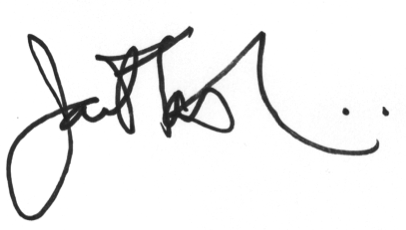
10 Reasons Why I Love Librarians
1. THEY KEEP ME LAUGHING ON LISTSERVS
I’m embarrassed to admit how many hours I’ve procrastinated by scanning my inbox for emails from ALA listservs, listening in on librarians dishing about character names, how to get teens involved in writing, and favorite books. Here’s what people in the business know that outsiders may not – librarians are HILARIOUS.
2. THEY KNOW HOW AND WHERE TO FIND ANYTHING
In my novel MULTIPLE CHOICE, the main character is obsessed with anagrams and other word puzzles. Being the semi-Luddite I am, a big chunk of my writing time was spent painstakingly constructing anagrams from scratch – until my hometown reference librarian Kathy Killeen asked me why I wasn’t using an online anagram generator. Changed. My. Life. Not only did I save myself months of work, I never could’ve come up with a gem like ASTRONOMERS = MOON STARERS on my own.
3. THEY HELP ME SCOUT OUT FURNITURE
When my public library was getting renovated, the local librarians knew what a library geek I was and told me about the super secret sale the town was having to sell off the old furniture. I was devastated to discover I was out of town on the designated day but my husband took pity and went in my place. Oak tables! Desk chairs! Wooden book carts with wheels! AN ATLAS STAND!! Coming home that night was like a dozen Christmases rolled into one.
4. THEY LET ME SLEEP AT THEIR HOUSE
When my son and I traveled way up to Blue Hill, Maine last year for a school visit, there was literally nowhere off-season to stay in this beautiful harbor town. Enter librarian Nancy Crowe who let us stay in her gorgeous home, replete with gluten-free breakfast. We had an amazing day of presentations, writing workshops, even an obstacle course in the schoolyard enacting scenes from MY LIFE AS A BOOK. That’s what I call some good old-fashioned Down-East hospitality.
5. THEY RALLY A SCHOOL AROUND ONE BOOK
I just love the One Book/One School events librarians champion in their towns. They’re a great way to get to know other readers in your community and get kids invested in a story with their friends. Theresa Robinett organized a giant event in Glendale, CA that got hundreds of kids excited about reading. In Oxford, CT, Jan Redfern is hiding a capuchin monkey doll from MY LIFE AS A STUNTBOY around the school for kids to discover with clues from the book. I’m taking a side trip from our vacation to stop in because I can’t bear the thought of missing out on so much fun with my characters and readers in a place that isn’t inside my head.
6. THEY SHARE MY QUEST TO CONQUER RELUCTANT READERS
One of my missions in life is to make a dent in this whole reluctant reader thing. I’m like a dog with a bone when it comes to writing books that are funny and exciting enough for reluctant readers (i.e. boys) to actually look forward to reading. Librarians are on the front lines of this important undertaking; I’m just happy to be fighting on their side.
7. THEY RECOMMEND THE PERFECT BOOK
I never would’ve picked up Gillian Flynn’s GONE GIRL if a friendly librarian at ALA hadn’t recommended it. And what I would’ve missed! I recommended the book to anyone who would listen and devoured Flynn’s other books straightaway. There are hundreds of books I could say that about; my rule is – if a librarian recommends it, it’s worth reading.
8. THEY LET ME TALK ABOUT RESEARCH
Nothing makes me happier on a school visit than when a librarian asks me to talk to students about doing research. For me, one of the true benefits of writing books is getting to learn about new subjects every day. Sir Francis Bacon, one of the fathers of the scientific method, died of pneumonia that he caught while STUFFING SNOW INTO A DEAD CHICKEN to study food preservation – are you kidding? You can’t make this stuff up – and no one knows how to find those kind of super-cool facts like librarians.
9. THEY GIVE ME A SENSE OF COMMUNITY
Writing novels is about as solitary as a job can be so it’s always a pleasure to meet people at conferences and school visits who devote as much time, effort, and LOVE to books as I do. It’s almost like a group of people with a secret language based on well…language. I feel less like a nerd than I usually do when I get to talk about characters and story and – dare I say it? – SENTENCES. Librarians make me feel like I belong.
10. THEY PUT MY BOOKS INTO KIDS’ HANDS
This, of course, is no small thing. If it weren’t for conscientious librarians and teachers, there’d be a lot of us making up stories for our own amusement without being able to share them with the readers we intend them for. I have stacks and stacks of letters from kids over the years – many from boys who read THE GOSPEL ACCORDING TO LARRY – saying how much the book meant to them, and that the only reason they read it was because their school librarian literally put it in their hand. If my editor is the midwife to my books, then librarians and teachers are the proud relatives, showing photos of my babies and bragging to anyone who’ll listen. And you need more than a special week to celebrate THAT kind of love – you need a lifetime.

